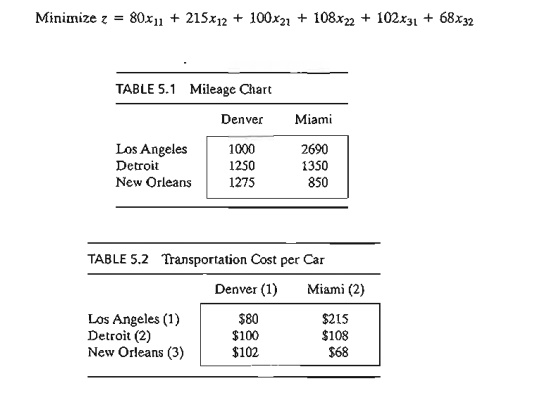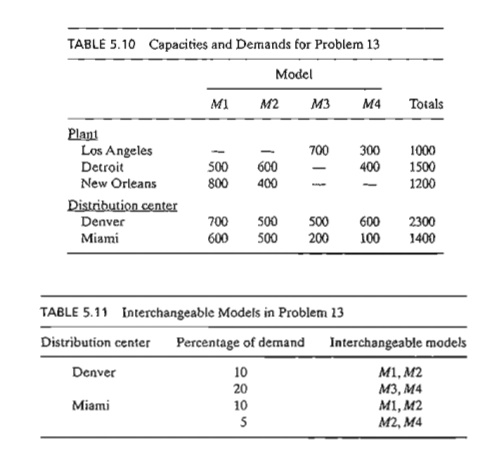Chapter: Operations Research: An Introduction : Transportation Model and Its Variants
Definition of the Transportation Model
DEFINITION OF THE TRANSPORTATION MODEL
The general problem is represented by the network in Figure 5.1. There
are m sources
and n destinations, each represented
by a node. The arcs represent the routes linking the sources and the destinations.
Arc (i, j) joining source i to destina-tion j carries two pieces of
information: the transportation cost per unit, Cij, and the amount shipped, Xij' The amount of supply at source i is ai and the amount of demand at destination j is bj • The
objective of the model is to determine the unknowns Xij that will
minimize the total transportation cost while satisfying all the supply and demand restrictions.
Example 5.1-1
MG Auto
has three plants in Los Angeles, Detroit, and New Orleans, and two major
distribution centers in Denver and Miami. The capacities of the three plants
during the next quarter are 1000, 1500, and 1200 cars. The quarterly demands at
the two distribution centers are 2300 and 1400 cars. The mileage chart between
the plants and the distribution centers is given in Table 5.l.
The
trucking company in charge of transporting the cars charges 8 cents per mile
per car.
The
transportation costs per car on the different routes, rounded to the closest
dollar, are given in Table 5.2.
The LP
model of the problem is given as


These
constraints are all equations because the total supply from the three sources
(= 1000 + 1500 + 1200 = 3700 cars) equals the total
demand at the two destinations (= 2300 + 1400 =
3700 cars).
The LP
model can be solved by the simplex method. However, with the special structure
of the constraints we can solve the problem more conveniently using the transportation tableau shown in Table
5.3.


The
optimal solution in Figure 5.2 (obtained by TORA) calls for shipping 1000 cars
from Los Angeles to Denver, 1300 from Detroit to Denver, 200 from Detroit to
Miami, and 1200 from New Orleans to Miami. The associated minimum
transportation cost is computed as 1000 x $80 + 1300 x $100 + 200 x
$108 + 1200 x $68 =
$313,200.
Balancing the Transportation Model. The
transportation algorithm is based on the assumption that the model is balanced,
meaning that the total demand equals the total supply. If the model is unbalanced, we can
always add a dummy source or a dummy destination to restore balance.
Example 5.1-2
In the MG
model, suppose that the Detroit plant capacity is 1300 cars (instead of 1500).
The total supply (= 3500
cars) is less than the total demand (= 3700 cars),
meaning that part of the demand at Denver and Miami will not be satisfied.
Because
the demand exceeds the supply, a dummy source (plant) with a capacity of 200
cars (= 3700 - 3500) is added to balance the transportation model. The unit
transportation costs from the dummy plant to the two destinations are zero
because the plant does not exist.
Table 5.4
gives the balanced model together with its optimum solution. The solution shows
that the dummy plant ships 200 cars to Miami, which means that Miami will be
200 cars short of satisfying its demand of 1400 cars.
We can
make sure that a specific destination does not experience shortage by assigning
a very high unit transportation cost from the dummy source to that destination.
For example, a penalty of $1000 in the dummy-Miami cell will prevent shortage
at Miami. Of course, we cannot use this "trick" with all the
destinations, because shortage must occur somewhere in the system.
TIle case
where the supply exceeds the demand can be demonstrated by assuming that the
demand at Denver is 1900 cars only. In this case, we need to add a dummy
distribution center to "receive" the surplus supply. Again, the unit
transportation costs to the dummy distribution center are zero, unless we
require a factory to "ship out" completely. In this case, we must
assign a high unit transportation cost from the designated factory to the dummy
destination.


PROBLEM SET 5.1A
1. True
or False?
a.
To balance a transportation model, it may be
necessary to add both a dummy source and a dummy destination.
b.
The amounts shipped to a dummy destination
represent surplus at the shipping source.
c.
The amounts shipped from a dummy source represent
shortages at the receiving destinations.
2. In
each of the following cases, determine whether a dummy source or a dummy
destination must be added to balance the model.

3. In
Table 5.4 of Example 5.1-2, where a dummy plant is added, what does the
solution mean when the dummy plant "ships" 150 cars to Denver and 50
cars to Miami?
*4. In
Table 5.5 of Example 5.1-2, where a dummy destination is added, suppose that
the De-troit plant must ship out all
its production. How can this restriction be implemented in the model?
5. In
Example 5.1-2, suppose that for the case where the demand exceeds the supply
(Table 5.4), a penalty is levied at the rate of $200 and $300 for each
undelivered car at Denver and Miami, respectively. Additionally, no deliveries
are made from the Los Angeles plant to the Miami distribution center. Set up
the model, and determine the optimal shipping schedule for the problem.
*6. Three
electric power plants with capacities of 25, 40, and 30 million kWh supply
electrici-ty to three cities. The maximum demands at the three cities are
estimated at 30, 35, and 25 million kWh. The price per million kWh at the three
cities is given in Table 5.6.
During
the month of August, there is a 20% increase in demand at each of the three
cities, which can be met by purchasing electricity from another network at a
premium rate of $1000 per million kWh. The network is not linked to city 3,
however. The utility company wishes to determine the most economical plan for
the distribution and pur-chase of additional energy.
a. Formulate
the problem as a transportation model.
b. Determine
an optimal distribution plan for the utility company.
c. Determine
the cost of the additional power purchased by each of the three cities.
7. Solve
Problem 6, assuming that there is a 10% power transmission loss through the
net-work.
8. Three
refineries with daily capacities of 6, 5, and 8 million gallons, respectively,
supply three distribution areas with daily demands of 4, 8, and 7 million
gallons, respectively. Gasoline is transported to the three distribution areas
through a network of pipelines.
The
transportation cost is 10 cents per 1000 gallons per pipeline mile. Table 5.7
gives the mileage between the refineries and the distribution areas. Refinery 1
is not connected to distribution area 3.
a)
Construct the associated transportation model.
b)
Determine the optimum shipping schedule in the
network.

*9. In
Problem 8, suppose that the capacity of refinery 3 is 6 million gallons only
and that distribution area 1 must receive all its demand. Additionally, any
shortages at areas 2 and 3 will incur a penalty of 5 cents per gallon.
a)
Formula,te the problem as a transportation model.
b)
Determine the optimum shipping schedule.
10. In
Problem 8, suppose that the daily demand at area 3 drops to 4 million gallons.
Surplus production at refineries 1 and 2 is diverted to other distribution
areas by truck. The trans-portation cost per 100 gallons is $1.50 from refinery
1 and $2.20 from refinery 2. Refinery 3 can divert its surplus production to
other chemical processes within the plant.
Formulate the problem as a transportation model.
Determine the optimum shipping schedule.
11. Three
orchards supply crates of oranges to four retailers. The daily demand amounts
at the four retailers are 150,150,400, and 100 crates, respectively. Supplies
at the three orchards are dictated by available regular labor and are estimated
at 150,200, and 250 crates daily. However, both orchards 1 and 2 have indicated
that they could supply more crates, if necessary, by using overtime labor.
Orchard 3 does not offer this option. The transportation costs per crate from
the orchards to the retailers are given in Table 5.8.
a)
Formulate the problem as a transportation model.
b)
Solve the problem.
c)
How many crates should orchards 1 and 2 supply
using overtime labor?
12. Cars
are shipped from three distribution centers to five dealers. The shipping cost
is based on the mileage between the sources and the destinations, and is
independent of whether the truck makes the trip with partial or full loads.
Table 5.9 summarizes the mileage between the distribution centers and the
dealers together with the monthly sup-ply and demand figures given in number of cars. A full truckload
includes 18 cars. The transportation cost per truck mile is $25.
a)
Fonnulate the associated transportation model.
b)
Determine the optimal shipping schedule.

13. MG
Auto, of Example 5.1-1, produces four car models: MI, M2, M3, and M4. The
Detroit. plant produces models Ml, M2,
and M4. Models MI and M2 are also
produced in New Orleans. The Los Angeles plant manufactures models M3 and M4. The capacities of the various plants and the demands at the
distribution centers are given in Table 5.10.
The
mileage chart is the same as given in Example 5.1-1, and the transportation
rate remains at 8 cents per car mile for all models. Additionally, it is
possible to satisfy a per-centage of the demand for some models from the supply
of others according to the speci-fications in Table 5.11.
a)
Formulate the corresponding transportation model.
b)
Determine the optimum shipping schedule.
(Hint:
Add four new destinations corresponding to the new combinations [MI, M2], [M3, M4], [Ml, M2], and [M2, M4]. The
demands at the new destinations are determined from the given percentages.)

Related Topics